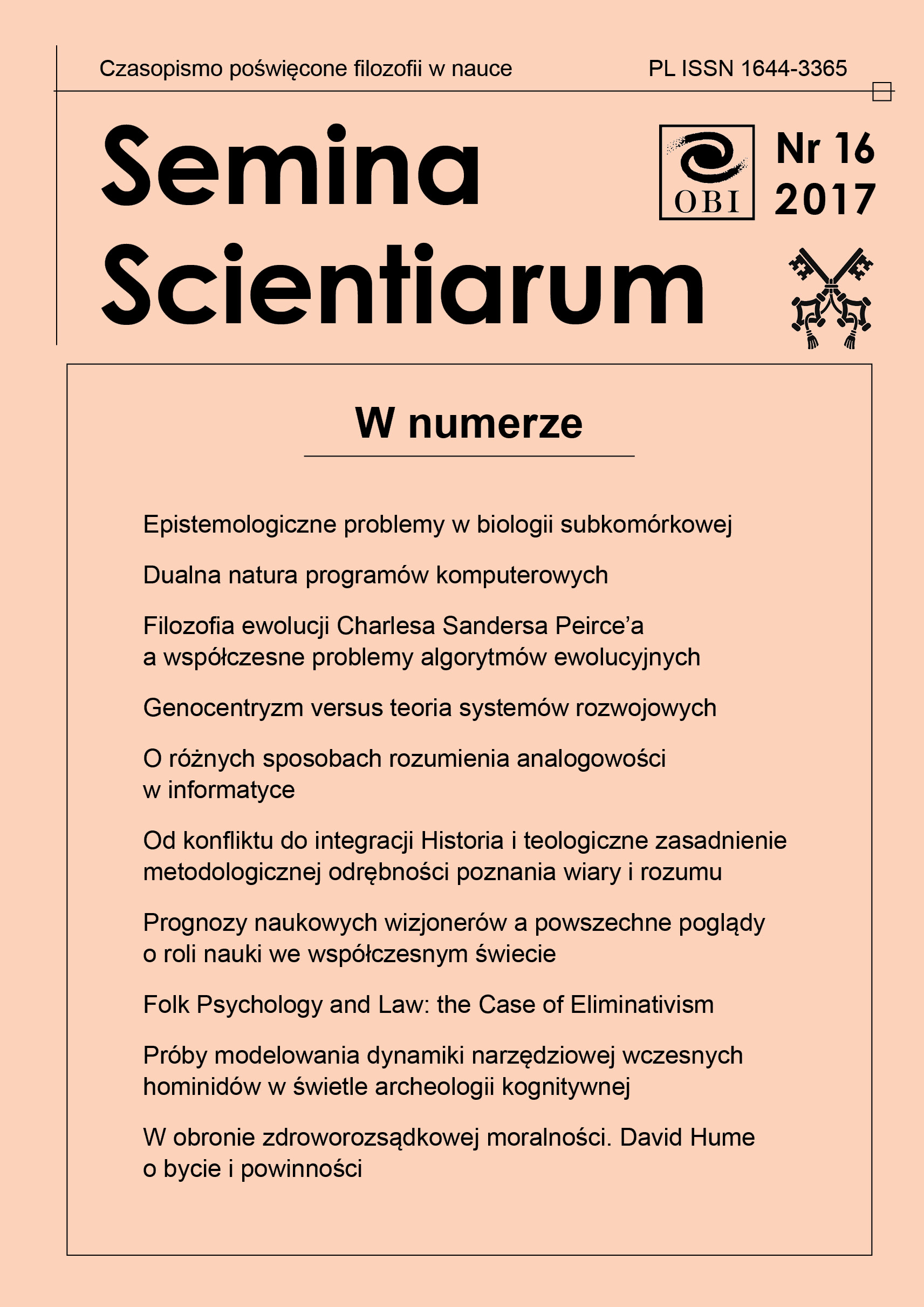Semantics and symbol grounding in Turing machine processes
DOI:
https://doi.org/10.15633/ss.2492Słowa kluczowe:
Steven Harnad, symbolic system, semantic system, symbol grounding problem, Turing machine, Turing test, Church-Turing Thesis, artificial intelligent, cognitionAbstrakt
The aim of the paper is to present the underlying reason of the unsolved symbol
grounding problem. The Church-Turing Thesis states that a physical problem,
for which there is an algorithm of solution, can be solved by a Turing
machine, but machine operations neglect the semantic relationship between
symbols and their meaning. Symbols are objects that are manipulated on rules
based on their shapes. The computations are independent of the context, mental
states, emotions, or feelings. The symbol processing operations are interpreted
by the machine in a way quite different from the cognitive processes.
Cognitive activities of living organisms and computation differ from each other,
because of the way they act in the real word. The result is the problem of
mutual understanding of symbol grounding.
Bibliografia
Cangelosi A., Greco A., Harnad S., Symbol Grounding and the Symbolic Theft
Hypothesis, in: Simulating the Evolution of Language, ed. A. Cangelosi,
D. Parisi, London 2002.
Copeland B. J., The Church-Turing Thesis, in: The Stanford Encyclopedia of
Philosophy, ed. E. N. Zalta, https://plato.stanford.edu/entries/church-turing
(28.11.2017).
De Saussure F., Nature of the Linguistic Sign, “Course in General Linguistics”
(1916), p. 65–70.
Fodor J., Pylyshyn Z. W., Connectionism and Cognitive Architecture: A Critical
Analysis, “Cognition” 28 (1988) iss. 1, p. 3–71.
Harnad S., Computation Is just Interpretable Symbol Manipulation; Cognition
Isn’t, “Minds and Machines” 4 (1994) iss. 4, p. 379–390.
Harnad S., The Symbol Grounding Problem, “Physica D: Nonlinear Phenomena”
(1990) iss. 1, p. 335–346.
MacDorman K., Cognitive Robotics. Grounding Symbols through Sensorimotor
Integration, “Journal of the Robotics Society of Japan” 17 (1999) no. 1,
p. 20–24.
Peirce C. S., The Essential Peirce: Selected Philosophical Writings, vol. 1, ed.
N. Houser, Bloomington 1998.
Piccinini G., Computation in Physical Systems, in: The Stanford Encyclopedia
of Philosophy, ed. E. N. Zalta, https://plato.stanford.edu/entries/computation-
physicalsystems (28.11.2017).
Professor Stevan Harnad, http://www.ecs.soton.ac.uk/people/harnad (22.11.2017).
Searle J. R., Minds, Brains, and Programs, “Behavioral and Brain Sciences”
(1980) iss. 3, p. 417–424.
Steels L., The Symbol Grounding Problem Has Been Solved, so What’s Next,
“Symbols and Embodiment: Debates on Meaning and Cognition” (2008),
p. 223–244.
Taddeo M., Floridi L., Solving the Symbol Grounding Problem: a Critical Review
of Fifteen Years of Research, “Journal of Experimental & Theoretical
Artificial Intelligence” 17 (2005) iss. 4, p. 419–445.
Turing A. M., Computing Machinery and Intelligence, “Mind” (1950), p. 433–
Turing A., Intelligent Machinery, a Heretical Theory, “B. Jack Copeland”
(2004), p. 465.
Pobrania
Opublikowane
Numer
Dział
Licencja
Twórca oświadcza, że przysługują mu prawa autorskie do utworu i że nie są ograniczone w zakresie objętym niniejszym oświadczeniem oraz że utwór jest dziełem oryginalnym i nie narusza praw autorskich innych osób.
Twórca zezwala Uniwersytetowi Papieskiemu Jana Pawła II w Krakowie na nieodpłatne, niewyłączne i nieograniczone w czasie korzystanie z utworu, to jest:
- utrwalanie i zwielokrotnianie: wytwarzanie egzemplarzy utworu techniką drukarską, reprograficzną, zapisu magnetycznego oraz techniką cyfrową;
- obrotu oryginałem albo egzemplarzami, na których utwór utrwalono (wprowadzanie do obrotu, użyczenie lub najem oryginału albo egzemplarzy, publiczne wystawienie, wyświetlenie, a także publiczne udostępnianie utworu w taki sposób, aby każdy mógł mieć do niego dostęp w miejscu i w czasie przez siebie wybranym);
- włączenie utworu w skład utworu zbiorowego;
- udzielanie przez Uniwersytet Papieski Jana Pawła II w Krakowie sublicencji Creative Commons Uznanie autorstwa-Użycie niekomercyjne-Bez utworów zależnych 3.0 Polska
Uniwersytet Papieski Jana Pawła II w Krakowie udostępnia utwór na Platformie Czasopism należącej do uczelni, na licencji Creative Commons Uznanie autorstwa-Użycie niekomercyjne-Bez utworów zależnych 3.0 Polska. Tym samym uprawnia wszystkich zainteresowanych do korzystania z utworu pod następującymi warunkami:
- zostanie podany autor i tytuł utworu,
- zostanie podane miejsce publikacji (tytuł czasopisma i adres internetowy do oryginalnie opublikowanego utworu),
- utwór będzie dystrybuowany w sposób niekomercyjny,
- nie będą tworzone utwory zależne.

